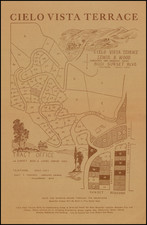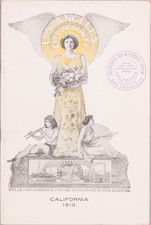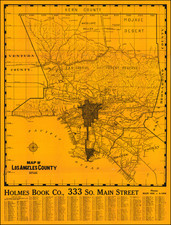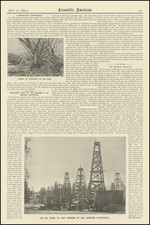I Am A Good Roads Map [of Los Angeles], printed by the Alles Printing Co. in Los Angeles and issued by the Good Roads Campaign Committee, offers a significant snapshot of the transportation aspirations of early 20th-century Southern California. It details the status of the existing roads and planned construction projects, advocating for the approval of a substantial bond issue intended to finance the further development of the county's highway system.
In the early decades of the 20th century, Los Angeles witnessed explosive growth, driven in part by its burgeoning film industry, a rapidly expanding population, and the advent of the automobile. Against this backdrop, the promotion and creation of an efficient road network was pivotal. The map delineates "good roads" both existing and proposed, accentuating the infrastructural vision of connecting urban centers with the rural outskirts. The significance of the Arroyo Seco Route, San Gabriel Route, and the ambitious "Sky Line" which spans the Sierra Madre mountains' ridge, elucidate the scope and scale of Los Angeles County's aspirations in regional connectivity.
The map serves multiple purposes. Beyond its primary function of informing the public about the state of the roads, it reflects the county's prioritization of specific routes, such as the connection between Palmdale and Victorville, intending to link with the "National Old Trails" Route. The "Ventura Road," bridging Ventura County with the Ridge Route, underscores the broader ambitions of integrating the various valleys within the county's purview.
The accompanying essay on the verso, advocating for a "yes" vote on the bond proposal, contextualizes the map within its sociopolitical milieu. It appeals to a broad cross-section of the county – from farmers and automobile owners to merchants and laborers – highlighting the perceived universal benefits of enhanced road infrastructure. This is a testament to the pivotal role road development played in shaping Los Angeles County's economic, social, and political landscape during the early 20th century.
The Good Roads Movement
The Good Roads Movement emerged in the late 19th and early 20th centuries as a response to the dire state of American roadways. At this time, the majority of U.S. roads were dirt tracks, which became virtually impassable quagmires during wet conditions and choked with dust in dry spells. Initially propelled by bicyclists who banded together to lobby for improved road surfaces, the movement gained significant momentum with the rise of the automobile.
As the number of cars began to increase, the demand for better roads surged, shifting the movement's emphasis from local to state and national arenas. Various organizations, such as the American Automobile Association (AAA) and the American Road Builders' Association, championed the cause. They advocated for systematic planning, professional engineering, and standardized road construction techniques. Their lobbying efforts were instrumental in the federal government's involvement in road funding and construction, culminating in the passage of the Federal Aid Road Act of 1916. This act marked the start of a partnership between the federal government and the states in road building, fundamentally transforming America's transportation landscape.











![[Hollywood / Los Angeles] Castle's Inc. Hollywood's Complete Camera Store](https://storage.googleapis.com/raremaps/img/small/73017.jpg)




